What distinguishes Asim Butt from his generation and perhaps the preceding generations of artists is the sheer originality of his vision and an iconoclasm that is neither trumpeted nor made visible until the subtext of his lines is closely studied.

This is why Asim has undertaken bold strides during the last 10 enriching years of painting. In the meantime, he also earned a degree or two in social sciences, a half-finished PhD at the University of California and formal training from Karachi’s Indus Valley school of Art and Architecture.
Art education in Pakistan, despite its deep- seated tradition of experimentation, does not allow the full exploration of originality. This is why the revival of miniatures has become another soft tool of marketisation and an out-of-wedlock union between art and commercialism. Rejecting what is on the horizon of Pakistani art, Asim Butt has stuck to his innate traumas and nightmares, sometimes indulging them, at others softening them with figures that blend the sensuous with the spiritual and the political with the existential.
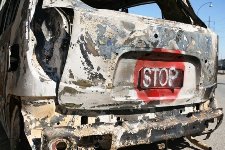

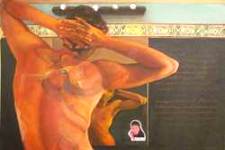
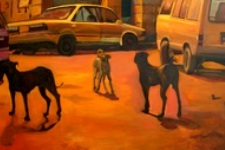
That his early works display a cracked sense of the self is not surprising. A rebel from his conventional background, Butt continues to defy the conformist meanings of family, career, security, sexuality and that elusive bourgeois pursuit of happiness. Inspired by the Stuckism movement of art, Asim holds painting as a powerful medium of communication. This standpoint brings our young Pakistani Stuckist at odds with the skin-deep novelty and claimed nihilism of “conceptual†art and postmodernism. The pursuit of art in this worldview thus merges into an impulse for a renewal of spiritual values in art and society, or what is known as “re-modernism.†In Asim’s own words:
“After the century-long assault on Beauty, an ideal obliterated by historical cataclysms such as the two World Wars and art movements reacting to them, I feel that it is perhaps time to re-imagine an Arcadia – fraught with Postmodern indeterminacy as it may be. In painting towards a new Beauty, it is not a neo-Romantic impulse of retreating into an idyll that I nurture. For art made today cannot be embarrassed of engaging the complexity of the historical moment of a globalizing multicultural society. Instead it is a tension between representing a shifting reality and an ideal beauty, or seen another way, between the social and emotional truths I experience and the tricks of illusion used to convey them that I seek to keep alive.â€
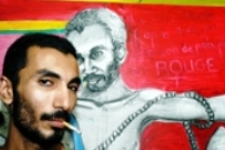
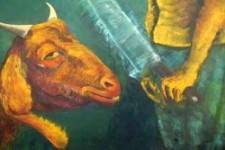
Since his return to Karachi in 2002, Asim has been both an introspective muse with bouts of self-doubt as well as a public art proponent. In 2003, he painted two murals outside the eighth century Sufi Abdullah Shah Ghazi. Not unlike the shrines of South Asia, Ghazi’s living Khanqah is a refuge for the under-class and the “scum†of the bourgeois society. The first mural, that consumed Asim like a mystic’s fire of love, was chillingly entitled, “5 Ways to Kill a Man,†and was based on the Iraq war; the second was about street children, particularly the glue-sniffing urchins with whom Asim engaged while painting the first mural. Quite symbolically, both the murals were, in due course, erased by the orthodoxy of municipal action.
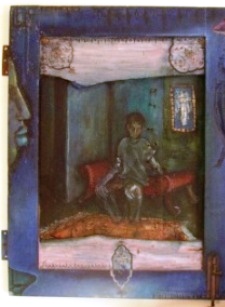
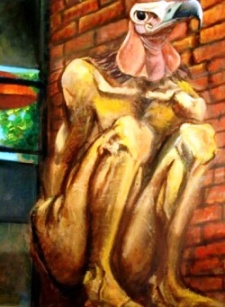
Asim could very well be making up for the anguish that he feels about commercialism and isolation of “studio art†from the sociability and performativity of public art. During the forays into street narratives, the Asim we knew was undergoing a transformation. A kind of inner path that was meandering and yet achieving definition. Faced with intractable personal relationships, Asim found a direction in this public exposition of art and its magic. In 2005, the Karachi chapter of the Stuckist art movement was created by Asim.
 Here was a twenty-something artist, working outside the boundaries of the hierarchy and patronage of the global art scene, in Pakistan no less. And therefore he invited a good measure of skepticism and muted resistance. This was reflected in his being banned from the Mohatta Palace Museum for one of his three interactive performative pieces which sought to claim the museum as a lived space.
Here was a twenty-something artist, working outside the boundaries of the hierarchy and patronage of the global art scene, in Pakistan no less. And therefore he invited a good measure of skepticism and muted resistance. This was reflected in his being banned from the Mohatta Palace Museum for one of his three interactive performative pieces which sought to claim the museum as a lived space.
Following his graduation from the Indus Valley School of Art and Architecture, Karachi in 2006, Asim has participated in various group shows across the country. By this time Asim was not the run-of-the-mill individual attempting to engineer a debut within the confines of collectors and galleries. A larger-than-art vision had taken root and it was to display itself in the tumult of 2007’s political events.
 Perhaps the resistance against the imposition of emergency in November 2007 offered a moment that took Asim to another level of Stuckism. Asim led an “art protest†movement, symbolised by the “eject†signs indicating the civilian struggles for the correction of civil-military imbalances. The project involved cutting a stencil out of stiff paper and spray-painting the stencilled symbol on to whatever surface was most appropriate. He also instructed his fellow protestors on how to cut stencils and use them to paint.
Perhaps the resistance against the imposition of emergency in November 2007 offered a moment that took Asim to another level of Stuckism. Asim led an “art protest†movement, symbolised by the “eject†signs indicating the civilian struggles for the correction of civil-military imbalances. The project involved cutting a stencil out of stiff paper and spray-painting the stencilled symbol on to whatever surface was most appropriate. He also instructed his fellow protestors on how to cut stencils and use them to paint.
For those tense months of November and onwards, Karachi witnessed the number “420? repeated to create large arrows at the Supreme Court, Karachi Bench; or the “Stop†signs on torched cars and gutted banks after Benazir Bhutto’s assassination. There is a good body of temporary public art to Asim’s credit: a mural done at the San Francisco Arts Commission Gallery reacting to the US “War on Terror,†another in Mumbai, one found on the walls of The Second Floor Café, Karachi, and what he calls a “scribble†at an Akharra in Lahore.
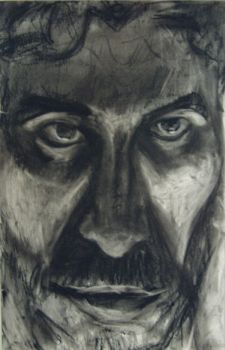
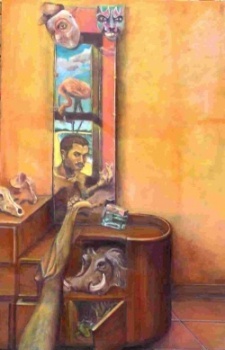
Asim’s recent art activism on the streets of Karachi, however, has not impeded his expansion as a studio artist. If anything, engagement with the political has provided further layers to the textual life of his studio art.
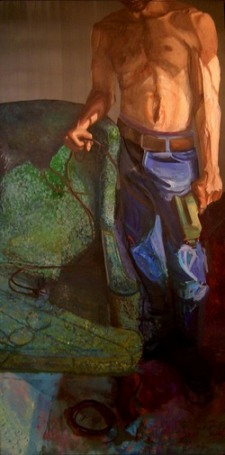 There is now a deeper penetration of the political into the personal, thereby detaching and undoing the existential from the hazards of nihilism. The lines are less anguished and more controlled; and the medium of oil on canvas acquires political tones conversing with the inner apparitions of the artist.
There is now a deeper penetration of the political into the personal, thereby detaching and undoing the existential from the hazards of nihilism. The lines are less anguished and more controlled; and the medium of oil on canvas acquires political tones conversing with the inner apparitions of the artist.
The problem with Asim and many others is not that they are shy of experimentation into new zones of art and existence. Their tragedy is that they live in a society that has yet to begin its search for identity; and turn the internal chaotic dynamic into a more conducive space for creativity. That said, the tremors generated by Pakistan’s fault lines also offer a near ideal arena for making a statement, both personal and political.
–Raza also edits and contributes at Pak Tea House and Lahore Nama



















































That Asim Butt was banned from the Mohatta Palace Museum, Karachi, Pakistan is not surprising. Proponents of Stuckism claim it to be an anti art-establishment movement with no particular use for the museums and art galleries. Its stance against Modernism and even Postmodernism makes it an ‘outsider’. But for how long? Street art and protest art has a short life span. An example would be the protest art of the sixties. It faded away with the stucco of the building walls it was painted on. Once it is done with the ‘noise making’, Stuck Art too will join the mainstream like all other movements before it. There is a museum even for Andy Warhol, the pop artist of the sixties and modern era. Perhaps inside Pakistan Asim Butt needs to look into places other than shrines to display his art. But the fact that he has joined an international art movement and put Pakistan on the world art stage is good for Pakistan. We need to be known for something other than Taleban.
Pakistan has a vibrant art scene centered in Karachi and, to a lesser degree, Lahore. I would suggest visiting the Canvas Gallery in Karachi (located in Clifton) or the Jehangir Art Gallery in Lahore (in Gulberg) to get a feeling for the high quality work that is available and whose prices continue to shoot through the roof. Outside of Pakistan, the Green Cardoman art gallery in London often has a good collection of Pakistani artists (particularly work by Miniaturists coming out of the National College of the Arts in Lahore). In the United States, Shahzia Sikander has been a huge success and her work (when one actually comes up for sale) routinely fetch upwards of $30,000.
Despite all this growth and perhaps owing to Pakistan’s many problems, the art scene in Pakistan has yet to attain the international acclaim and auction house success of contemporary art from India. I once met Ali Imam (the doyen of Pakistani gallery owners) who told me that, by and large, Pakistani painters were derivative and had yet to cross the divide into a truly personal-0riginal style.
I live outside of Pakistan, but whenever I do return, I immediately head to the galleries in Karachi and have found amazing work by artists such as Mansoor Salim, Iqbal Mehdi, Afshar Malik, and Bashir Mirza.
A good source of information on Pakistani Art is a text by Marcella Sirhandi who teaches at Oklahoma State University.
Raza Sahib, I can’t thank you enough for this post. I am ashamed of my non existent knowledge of Pakistani art. The only artist I had heard about was Gull Jee and that was because he made some rare appearance on PTV.
In 2000, on my visit to Pakistan, I implored a friend of mine, who was residing in Islamabad, to take me some art galleries/artists. We spent an entire afternoon wondering on the streets of the capital city with no luck. Maybe it was lack of information on my friend’s part or maybe all artist were in hibernation but we only manged to find one individual. It was a broken down place with inadequate light ; there were some canvases sitting on the floor but no real work to be seen. Moreover I found the artist to be very cold and non-forthcoming. ( I know that artists, by virtue of their skill, are expected to be eccentric, broody etc but that person was just plain indifferent and non passionate.
We finally ended up on some kind of high end place in Jinnah Market and the arts they were selling was ‘Made in China”.
I also find it unfortunate that I never get any opportunity to see Art exhibitions at the Pakistani Embassy here in Washington D.C.
Asim’s work is intriguing. The picture of the street with cars and dogs remind me a bit of Edward Hopper.
I would love the opportunity to see his art first hand.
@ Bakra, Qasai, holnaaki, mauzu hay apka,
Ghaur karein to barehnagi, libas hey apka
One word: Impressive!